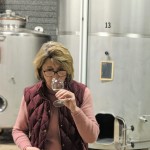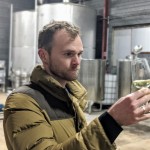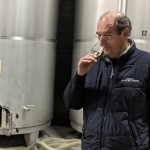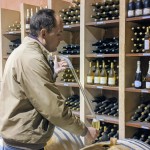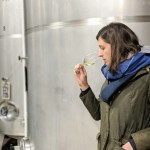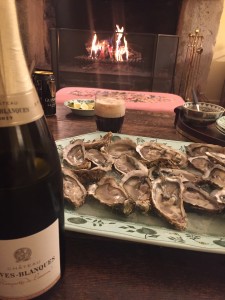Saturday 7 December
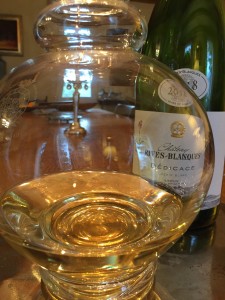 Christmas comes early to Rives-Blanques! In this weekend’s Financial Times, the wine expert’s expert, Jancis Robinson MW, comes up with her list of 26 white wines from all corners of the globe for the festivities, rated on price-quality considerations.
Christmas comes early to Rives-Blanques! In this weekend’s Financial Times, the wine expert’s expert, Jancis Robinson MW, comes up with her list of 26 white wines from all corners of the globe for the festivities, rated on price-quality considerations.
Absolutely thrilled, and also very honoured, to see our chenin blanc, Dédicace in the No 4 slot.
White wine can be even more beguiling in a decanter than red, she says. Oh yes, ma’am: now you’re talking. Yes! to decanting a white wine. Yes! to having it with cheese. And a great big Yes! to the FT’s selection!
Dreaming of a white Christmas indeed.
Friday 13 December
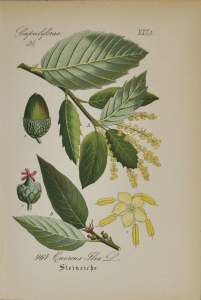 Incredible storm hits us. 50 k per hour winds. No damage.
Incredible storm hits us. 50 k per hour winds. No damage.
But we worry about our Quercus Ilex, the young 20-year old oak planted in what will be the pinot field, lifting its head above the parapets of the high terrace on which we perch, to face the buffeting winds full on. It is stirred, but not too badly shaken.
It means Holly Oak in English, because of the shape of its leaves. It’s persistent, consistent and robust, but likes a nice protected spot. Which this is not. It’s a spot that shows its profile off from afar and from all directions. It can grow 25 m tall at the rate of 25 cm per year, so our Quercus Ilex still has a few decades to go – not all that long, in the life of an oak, but way beyond our own scope. I read somewhere that they are great for littering the top soil with leaves (a good thing) and they also provide a wonderful habitat for monkeys and bears – if it’s growing on the Indian sub-continent, that is (which it does, apparently, though this one isn’t). That may come in useful at some point, even if one doesn’t immediately see when. A learned thesis also tells us that this ancient indigenous native of the Mediterranean is “highly recommended for planting in dry temperate areas of the Western Himalayas”. So versatile, how can we go wrong?!
We’ve been trying to work out how much of our carbon footprint is absorbed by the 431 oaks we planted this year. Not much, seems to be the (sadly truthful) answer. Jan-Ailbe has calculated that a fermenting wine gives off 5 litres of CO2 per litre, but he may be wrong. On Twitter, someone said that only 134.08 g. per litre are emitted. And it takes a tree 100 years to absorb what a single person produces in a single year . But is that all true?
In the UK, as a part of their various and vying elections campaigns, the political parties have been outbidding each other with wild promises of thousands, no millions, no billions of trees to be planted at the rate of 117 per minute or some such, to offset carbon emissions. We calculate that our one-hundred-and-forty-three oaks will eventually offset the fermentation of one single cuvée per year, say Dédicace (if that’s true). Tree planting may be part of the solution, but it doesn’t seem to be the solution, even if our facts and figures may be a bit wonky.
So it may be best to consider our Quercus Ilex just as a safe haven for passing wild and birdlife, and resting spot for hot and weary walkers.
Saturday December 14
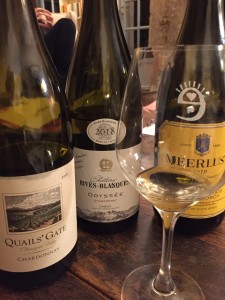 Well, why not? Daughter Xaxa and her husband, Ian, organise a small blind tasting for us: this is our favourite family game, one that replaced scrabble and bridge and monopoly before that, decades ago.
Well, why not? Daughter Xaxa and her husband, Ian, organise a small blind tasting for us: this is our favourite family game, one that replaced scrabble and bridge and monopoly before that, decades ago.
Ian’s Canadian, so the mindset is Canada – or thereabouts. And I can’t get it out of my head. Canada! the first bottle shouted at me (or maybe Oregon, at a pinch. Not all that far away, after all.) Canada! the second bottle shouted, in a rather more elegant and refined voice than the first. And Canada? the third bottle questioned, rather similar to No 2 but somehow more authentic and less tampered, perhaps.
And did any of us say that they were all Chardonnays?
And that only one of them was Canadian?
Not even a blind tasting is completely in the dark. You still have to wrestle with the presumptions and assumptions of your mind.
Monday December 16
More tasting. Now we move down to the cellars to the cellars to taste again some of our 2019 wines.
The Pays d’Oc is ready for bottling, and we’re really pleased with it. The Blanquette is ready for fermenting all over again in the bottle, and is also really lovely. Potentially, that is. Everything is potential in this business. Nothing’s in the bag until it’s in the bottle.
And then we move into the barrel cellar and test taste the chardonnay in its brand-new 500 l. barrels, made by two different coopers. There’s a difference between the coopers, and there’s also a difference between the wines, depending on which field they came from.
Lots of serious faces in the cellars, but lots of smiles when we came out of it.
Thursday 19 December
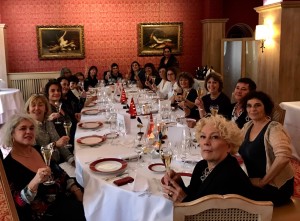 The AGM followed by a delicious lunch at a local Michelin star restaurant, l’Auriac, today with the Vinifilles, the Association of Languedoc female winegrowers. We may be a disparate, no, a desperate, bunch, but there is a common interest that binds these women together in a way I have never known before. It must be the job that does it: the sheer beauty and the absolute awfulness of it. The Auriac’s elegant oval table naturally shapes itself into an elegant display case for this unlikely necklace of cameos … talking cameos (and how!) with stories to tell (and how!) about being wiped out by hail, evacuated because of forest fires, vines burnt simply from excessive climate-change heat, uncooperative siblings who want to sell the old family property, husbands who can’t hack the heat, crippling accidents in the cellar during the harvest, vintages lost to mildew. It’s never ending. So here we are, 18 women who have spent the morning talking about Trump’s trade tariffs and if we should go the USA or not to show our wines, or what we are going to do to help the local sommelier school, or how we’re going to arrange ourselves at various international trade fairs, now swapping gossip, sharing our old vintages, and taking huge, deep, restorative breaths of a funny, fraternal kind of friendship.
The AGM followed by a delicious lunch at a local Michelin star restaurant, l’Auriac, today with the Vinifilles, the Association of Languedoc female winegrowers. We may be a disparate, no, a desperate, bunch, but there is a common interest that binds these women together in a way I have never known before. It must be the job that does it: the sheer beauty and the absolute awfulness of it. The Auriac’s elegant oval table naturally shapes itself into an elegant display case for this unlikely necklace of cameos … talking cameos (and how!) with stories to tell (and how!) about being wiped out by hail, evacuated because of forest fires, vines burnt simply from excessive climate-change heat, uncooperative siblings who want to sell the old family property, husbands who can’t hack the heat, crippling accidents in the cellar during the harvest, vintages lost to mildew. It’s never ending. So here we are, 18 women who have spent the morning talking about Trump’s trade tariffs and if we should go the USA or not to show our wines, or what we are going to do to help the local sommelier school, or how we’re going to arrange ourselves at various international trade fairs, now swapping gossip, sharing our old vintages, and taking huge, deep, restorative breaths of a funny, fraternal kind of friendship.
Sunday 22 December
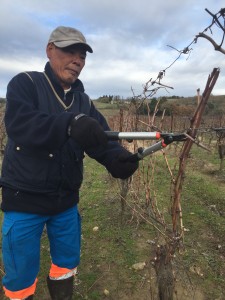 Don’t quite know what’s got into Mr Li. He’s finished pruning the top appellation fields, all in accordance with the phases of the moon, something he quietly approves of. It seems to sit well with his Buddhist beliefs. He never talks, just prunes and prunes, like a machine. He wants to get on with his pruning, of course he does, he is paid by the vine. He doesn’t use any electrical rubbish, just off-fashioned cutters. And likes to get on with it. It’s a tough job, and he is a tough man.
Don’t quite know what’s got into Mr Li. He’s finished pruning the top appellation fields, all in accordance with the phases of the moon, something he quietly approves of. It seems to sit well with his Buddhist beliefs. He never talks, just prunes and prunes, like a machine. He wants to get on with his pruning, of course he does, he is paid by the vine. He doesn’t use any electrical rubbish, just off-fashioned cutters. And likes to get on with it. It’s a tough job, and he is a tough man.
But today he wants to talk. He puts down his secateurs, leans back comfortably against the trellising, and talks. Talks about how his family left Vietnam in 1985. He spent a few years in Malaysia before coming to France where his elder brother was already established: the same elder brother whose restaurant is on the Nice esplanade where a terrorist ran amok in a truck on 14 July a couple of years ago. About his brother’s wife, who talks and talks and talks. And then on to his brothers in Canada and in Australia, and also in America possibly, who all prepared papers for Mr Li to join them on their respective continents, but the big brother and his talk-talk-talking wife didn’t like that. Understanding Mr Li requires a mix of inspiration, intuition, and a smattering of other random languages, so it is never very easy. This must be about his tenth year or so with us, and he has never said so much in so little time, or with such little evidence of even ever wanting to stop. I prise myself away eventually and let him get on with it.
Monday 23 December
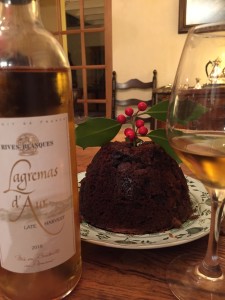 We’ve been getting into the Christmas spirit test-tasting what wines to go with what. It was mostly about the Christmas pudding, and we didn’t have to go far from home: our 100% chenin blanc late harvest filled the bill perfectly (actually a terrific combination).
We’ve been getting into the Christmas spirit test-tasting what wines to go with what. It was mostly about the Christmas pudding, and we didn’t have to go far from home: our 100% chenin blanc late harvest filled the bill perfectly (actually a terrific combination).
The wine for the roast ham, a hugely expensive Bordeaux (Lynch Bages 5 cru 2016) and the wine for the blinis with salmon eggs, a much more modestly priced biodynamic Loire Savennières (Nicolas Joly 2017) were emphatically kept out of sight by the kitchen marshal to be served up decanted during dinner, for everyone 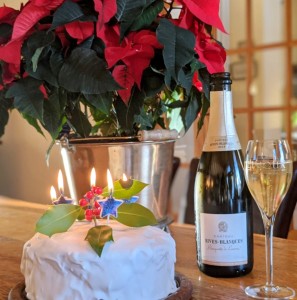 to guess appellation and year.
to guess appellation and year.
But then we stumbled on a surprise: Blanquette with Christmas cake! Now that was something we had never expected, or even looked for. But why not?
Tea became rather jolly.
Tuesday 24 December
Traditionally, we have oysters at New Year’s, but this year we have a sneak peak on Christmas Eve around the fire. And make another discovery! Black Velvet with oysters! That is, a Black Velvet made of Guiness (poured first) and Blanquette de Limoux.
Really, quite getting into the spirit of Christmas …
Thursday 26 December
We pass Mr Li again today on the way to the Trois Pechs where Jan-Ailbe is 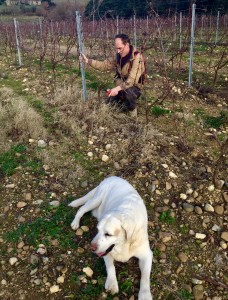 treating the young vines to their second year of ‘soft pruning’. Soft pruning? We’ll get to that when we get to that; which is to say after we have navigated past the suddenly talkative Mr Li and he has said what he wants to say. His Christmas was a mix of vegetarian Vietnam and French dishes, the latter because his children are married to French nationals. He, as a good Buddhist, doesn’t ever say a bad thing about anyone (apart from the talk-talk-talking sister-in-law), and nor will he allow any animal to be mistreated or killed. He doesn’t approve of the boar hunt, the chasse which comes and shoots over his head, and thankfully, has missed him so far. The Chasse is a hot subject at Rives-Blanques, but never mind. Mr Li is not on their side – and nor are a number of us either.
treating the young vines to their second year of ‘soft pruning’. Soft pruning? We’ll get to that when we get to that; which is to say after we have navigated past the suddenly talkative Mr Li and he has said what he wants to say. His Christmas was a mix of vegetarian Vietnam and French dishes, the latter because his children are married to French nationals. He, as a good Buddhist, doesn’t ever say a bad thing about anyone (apart from the talk-talk-talking sister-in-law), and nor will he allow any animal to be mistreated or killed. He doesn’t approve of the boar hunt, the chasse which comes and shoots over his head, and thankfully, has missed him so far. The Chasse is a hot subject at Rives-Blanques, but never mind. Mr Li is not on their side – and nor are a number of us either.
But to the “soft pruning”, a slower more contemplative version of Mr Li’s pruning. Jan-Ailbe explains: if you don’t cut between the first bud on either side of the trunk and the root system below, you will get vines that are more resilient, more resistant to disease, and longer-lived. Well, that’s the theory, though it will take couple of decades to prove it. The video under the photo tells all.
…./to be continued.
…/to be cont’d

